Accounting for Business Decisions - T2 2019, Holmes Institute
VerifiedAdded on 2022/12/27
|6
|1468
|91
Report
AI Summary
This report analyzes key aspects of accounting for business decisions, focusing on the challenges Tim faces when starting a business. It begins by comparing sole proprietorships and partnerships, outlining their advantages and disadvantages. The report then explores how the choice of business structure influences financing options, including personal savings, bank loans, and venture capital. The importance of both financial and non-financial information for making informed business decisions, such as purchasing a business, is discussed. The report highlights the essential skills and accounting knowledge required for effective business management, including financial management, marketing, communication, and leadership. The conclusion recommends a partnership structure for Tim to facilitate greater access to funding and emphasizes the need for comprehensive financial and non-financial due diligence. The report is based on the assignment brief for HC1010 Accounting for Business Decisions, T2 2019 at Holmes Institute.

Running head: ACCOUNTING FOR BUSINESS DECISIONS
Accounting for Business Decisions
Name of the Student
Name of the University
Author’s Note
Accounting for Business Decisions
Name of the Student
Name of the University
Author’s Note
Paraphrase This Document
Need a fresh take? Get an instant paraphrase of this document with our AI Paraphraser
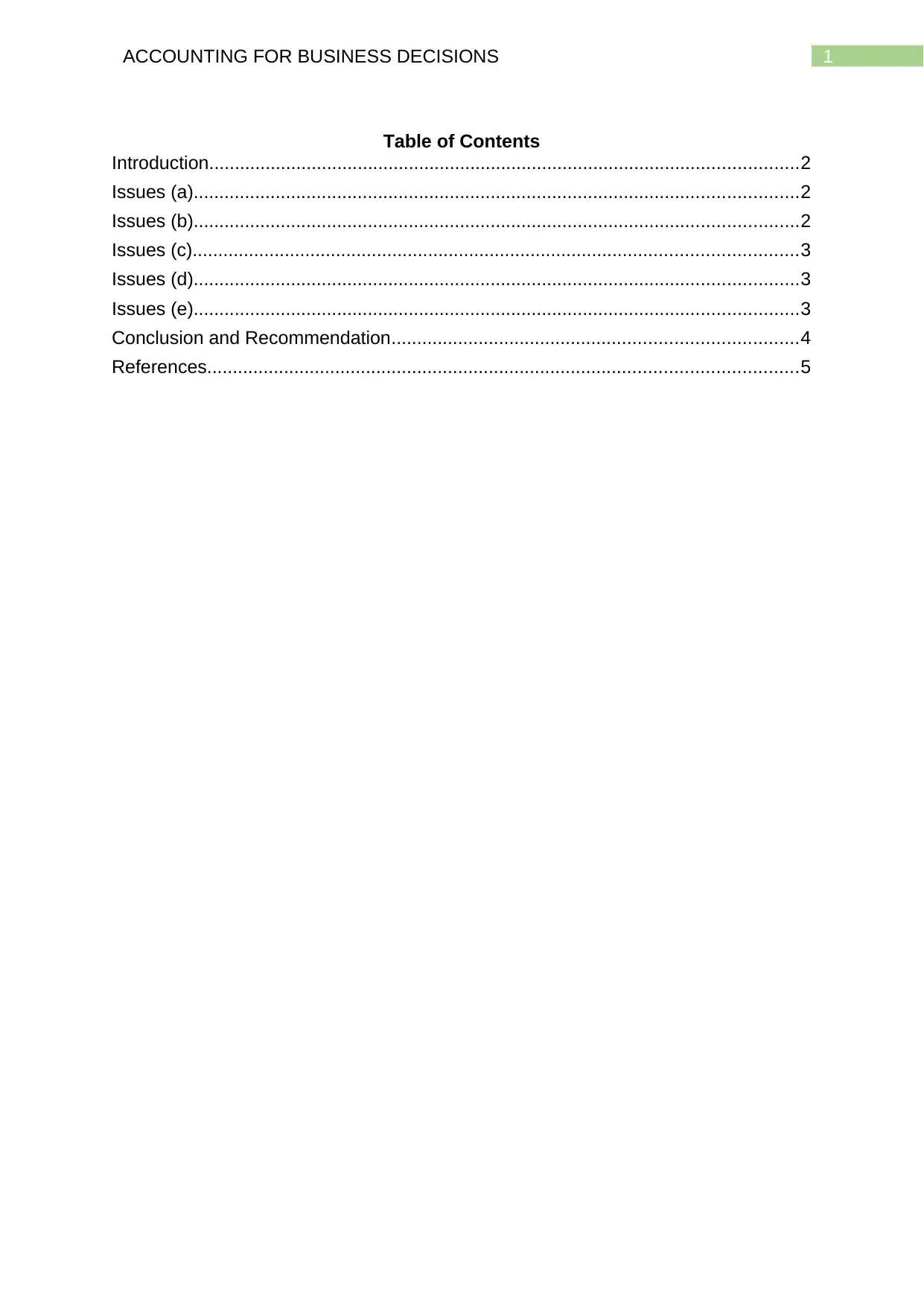
1ACCOUNTING FOR BUSINESS DECISIONS
Table of Contents
Introduction...................................................................................................................2
Issues (a)......................................................................................................................2
Issues (b)......................................................................................................................2
Issues (c)......................................................................................................................3
Issues (d)......................................................................................................................3
Issues (e)......................................................................................................................3
Conclusion and Recommendation...............................................................................4
References...................................................................................................................5
Table of Contents
Introduction...................................................................................................................2
Issues (a)......................................................................................................................2
Issues (b)......................................................................................................................2
Issues (c)......................................................................................................................3
Issues (d)......................................................................................................................3
Issues (e)......................................................................................................................3
Conclusion and Recommendation...............................................................................4
References...................................................................................................................5
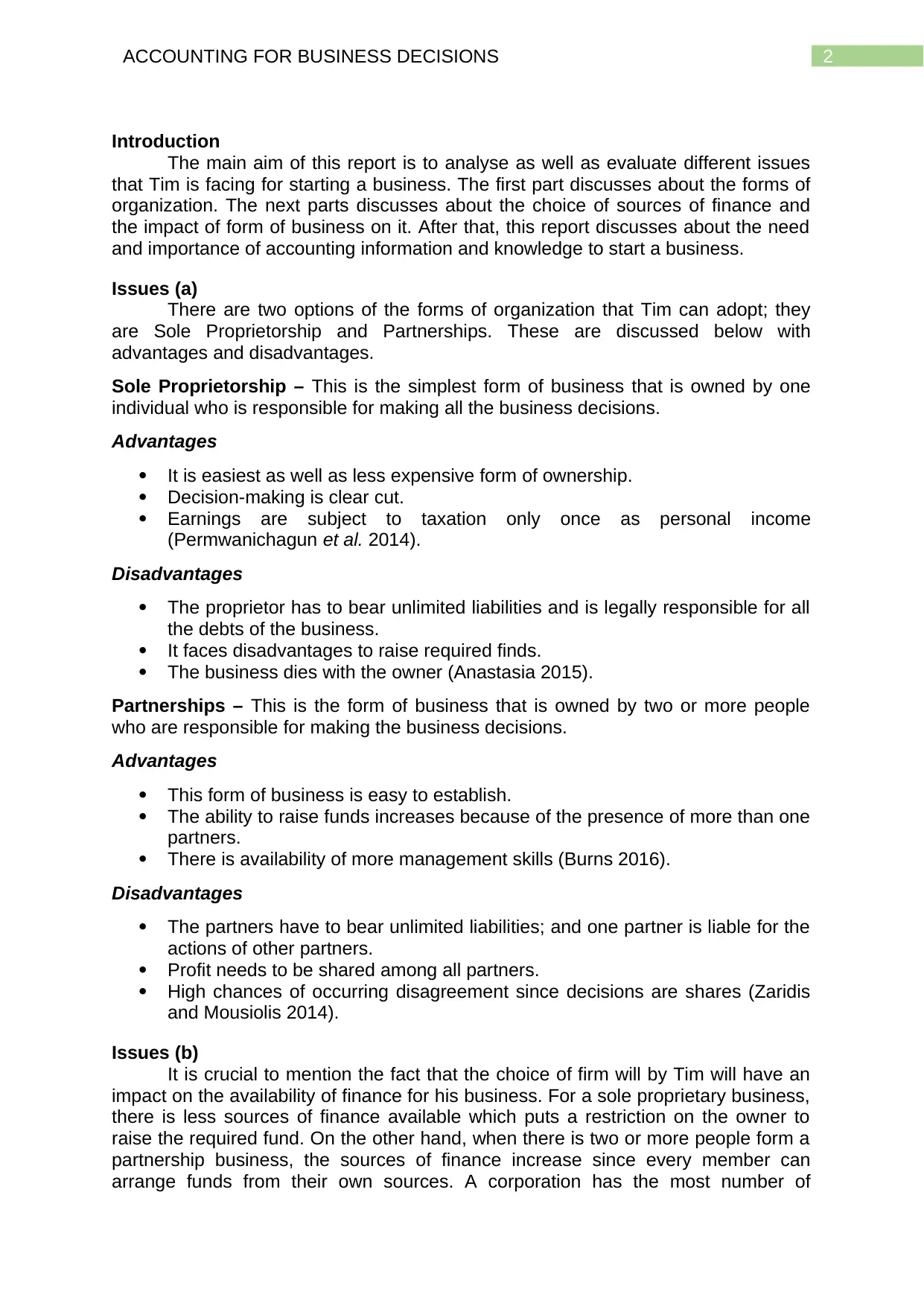
2ACCOUNTING FOR BUSINESS DECISIONS
Introduction
The main aim of this report is to analyse as well as evaluate different issues
that Tim is facing for starting a business. The first part discusses about the forms of
organization. The next parts discusses about the choice of sources of finance and
the impact of form of business on it. After that, this report discusses about the need
and importance of accounting information and knowledge to start a business.
Issues (a)
There are two options of the forms of organization that Tim can adopt; they
are Sole Proprietorship and Partnerships. These are discussed below with
advantages and disadvantages.
Sole Proprietorship – This is the simplest form of business that is owned by one
individual who is responsible for making all the business decisions.
Advantages
It is easiest as well as less expensive form of ownership.
Decision-making is clear cut.
Earnings are subject to taxation only once as personal income
(Permwanichagun et al. 2014).
Disadvantages
The proprietor has to bear unlimited liabilities and is legally responsible for all
the debts of the business.
It faces disadvantages to raise required finds.
The business dies with the owner (Anastasia 2015).
Partnerships – This is the form of business that is owned by two or more people
who are responsible for making the business decisions.
Advantages
This form of business is easy to establish.
The ability to raise funds increases because of the presence of more than one
partners.
There is availability of more management skills (Burns 2016).
Disadvantages
The partners have to bear unlimited liabilities; and one partner is liable for the
actions of other partners.
Profit needs to be shared among all partners.
High chances of occurring disagreement since decisions are shares (Zaridis
and Mousiolis 2014).
Issues (b)
It is crucial to mention the fact that the choice of firm will by Tim will have an
impact on the availability of finance for his business. For a sole proprietary business,
there is less sources of finance available which puts a restriction on the owner to
raise the required fund. On the other hand, when there is two or more people form a
partnership business, the sources of finance increase since every member can
arrange funds from their own sources. A corporation has the most number of
Introduction
The main aim of this report is to analyse as well as evaluate different issues
that Tim is facing for starting a business. The first part discusses about the forms of
organization. The next parts discusses about the choice of sources of finance and
the impact of form of business on it. After that, this report discusses about the need
and importance of accounting information and knowledge to start a business.
Issues (a)
There are two options of the forms of organization that Tim can adopt; they
are Sole Proprietorship and Partnerships. These are discussed below with
advantages and disadvantages.
Sole Proprietorship – This is the simplest form of business that is owned by one
individual who is responsible for making all the business decisions.
Advantages
It is easiest as well as less expensive form of ownership.
Decision-making is clear cut.
Earnings are subject to taxation only once as personal income
(Permwanichagun et al. 2014).
Disadvantages
The proprietor has to bear unlimited liabilities and is legally responsible for all
the debts of the business.
It faces disadvantages to raise required finds.
The business dies with the owner (Anastasia 2015).
Partnerships – This is the form of business that is owned by two or more people
who are responsible for making the business decisions.
Advantages
This form of business is easy to establish.
The ability to raise funds increases because of the presence of more than one
partners.
There is availability of more management skills (Burns 2016).
Disadvantages
The partners have to bear unlimited liabilities; and one partner is liable for the
actions of other partners.
Profit needs to be shared among all partners.
High chances of occurring disagreement since decisions are shares (Zaridis
and Mousiolis 2014).
Issues (b)
It is crucial to mention the fact that the choice of firm will by Tim will have an
impact on the availability of finance for his business. For a sole proprietary business,
there is less sources of finance available which puts a restriction on the owner to
raise the required fund. On the other hand, when there is two or more people form a
partnership business, the sources of finance increase since every member can
arrange funds from their own sources. A corporation has the most number of
⊘ This is a preview!⊘
Do you want full access?
Subscribe today to unlock all pages.

Trusted by 1+ million students worldwide
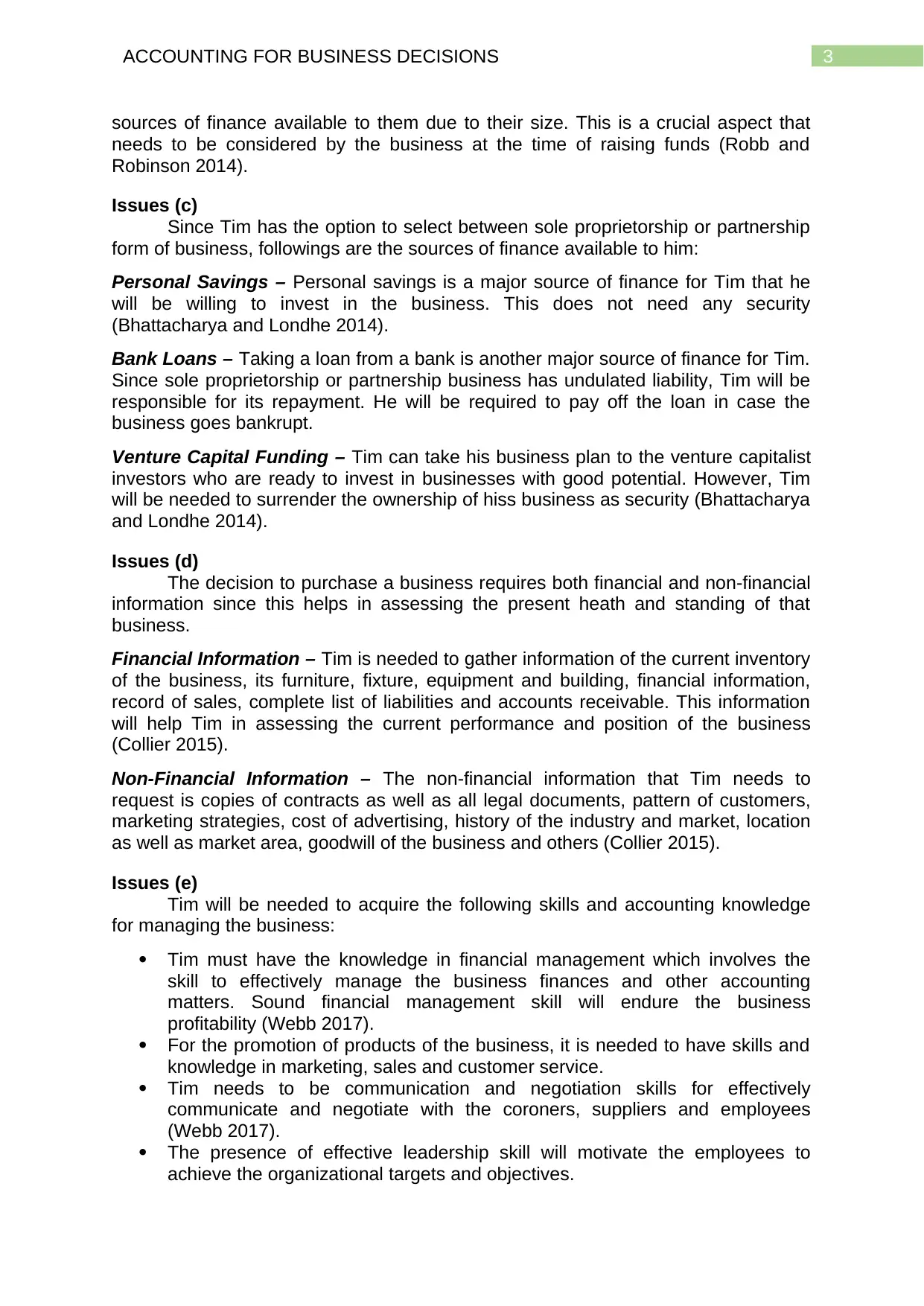
3ACCOUNTING FOR BUSINESS DECISIONS
sources of finance available to them due to their size. This is a crucial aspect that
needs to be considered by the business at the time of raising funds (Robb and
Robinson 2014).
Issues (c)
Since Tim has the option to select between sole proprietorship or partnership
form of business, followings are the sources of finance available to him:
Personal Savings – Personal savings is a major source of finance for Tim that he
will be willing to invest in the business. This does not need any security
(Bhattacharya and Londhe 2014).
Bank Loans – Taking a loan from a bank is another major source of finance for Tim.
Since sole proprietorship or partnership business has undulated liability, Tim will be
responsible for its repayment. He will be required to pay off the loan in case the
business goes bankrupt.
Venture Capital Funding – Tim can take his business plan to the venture capitalist
investors who are ready to invest in businesses with good potential. However, Tim
will be needed to surrender the ownership of hiss business as security (Bhattacharya
and Londhe 2014).
Issues (d)
The decision to purchase a business requires both financial and non-financial
information since this helps in assessing the present heath and standing of that
business.
Financial Information – Tim is needed to gather information of the current inventory
of the business, its furniture, fixture, equipment and building, financial information,
record of sales, complete list of liabilities and accounts receivable. This information
will help Tim in assessing the current performance and position of the business
(Collier 2015).
Non-Financial Information – The non-financial information that Tim needs to
request is copies of contracts as well as all legal documents, pattern of customers,
marketing strategies, cost of advertising, history of the industry and market, location
as well as market area, goodwill of the business and others (Collier 2015).
Issues (e)
Tim will be needed to acquire the following skills and accounting knowledge
for managing the business:
Tim must have the knowledge in financial management which involves the
skill to effectively manage the business finances and other accounting
matters. Sound financial management skill will endure the business
profitability (Webb 2017).
For the promotion of products of the business, it is needed to have skills and
knowledge in marketing, sales and customer service.
Tim needs to be communication and negotiation skills for effectively
communicate and negotiate with the coroners, suppliers and employees
(Webb 2017).
The presence of effective leadership skill will motivate the employees to
achieve the organizational targets and objectives.
sources of finance available to them due to their size. This is a crucial aspect that
needs to be considered by the business at the time of raising funds (Robb and
Robinson 2014).
Issues (c)
Since Tim has the option to select between sole proprietorship or partnership
form of business, followings are the sources of finance available to him:
Personal Savings – Personal savings is a major source of finance for Tim that he
will be willing to invest in the business. This does not need any security
(Bhattacharya and Londhe 2014).
Bank Loans – Taking a loan from a bank is another major source of finance for Tim.
Since sole proprietorship or partnership business has undulated liability, Tim will be
responsible for its repayment. He will be required to pay off the loan in case the
business goes bankrupt.
Venture Capital Funding – Tim can take his business plan to the venture capitalist
investors who are ready to invest in businesses with good potential. However, Tim
will be needed to surrender the ownership of hiss business as security (Bhattacharya
and Londhe 2014).
Issues (d)
The decision to purchase a business requires both financial and non-financial
information since this helps in assessing the present heath and standing of that
business.
Financial Information – Tim is needed to gather information of the current inventory
of the business, its furniture, fixture, equipment and building, financial information,
record of sales, complete list of liabilities and accounts receivable. This information
will help Tim in assessing the current performance and position of the business
(Collier 2015).
Non-Financial Information – The non-financial information that Tim needs to
request is copies of contracts as well as all legal documents, pattern of customers,
marketing strategies, cost of advertising, history of the industry and market, location
as well as market area, goodwill of the business and others (Collier 2015).
Issues (e)
Tim will be needed to acquire the following skills and accounting knowledge
for managing the business:
Tim must have the knowledge in financial management which involves the
skill to effectively manage the business finances and other accounting
matters. Sound financial management skill will endure the business
profitability (Webb 2017).
For the promotion of products of the business, it is needed to have skills and
knowledge in marketing, sales and customer service.
Tim needs to be communication and negotiation skills for effectively
communicate and negotiate with the coroners, suppliers and employees
(Webb 2017).
The presence of effective leadership skill will motivate the employees to
achieve the organizational targets and objectives.
Paraphrase This Document
Need a fresh take? Get an instant paraphrase of this document with our AI Paraphraser
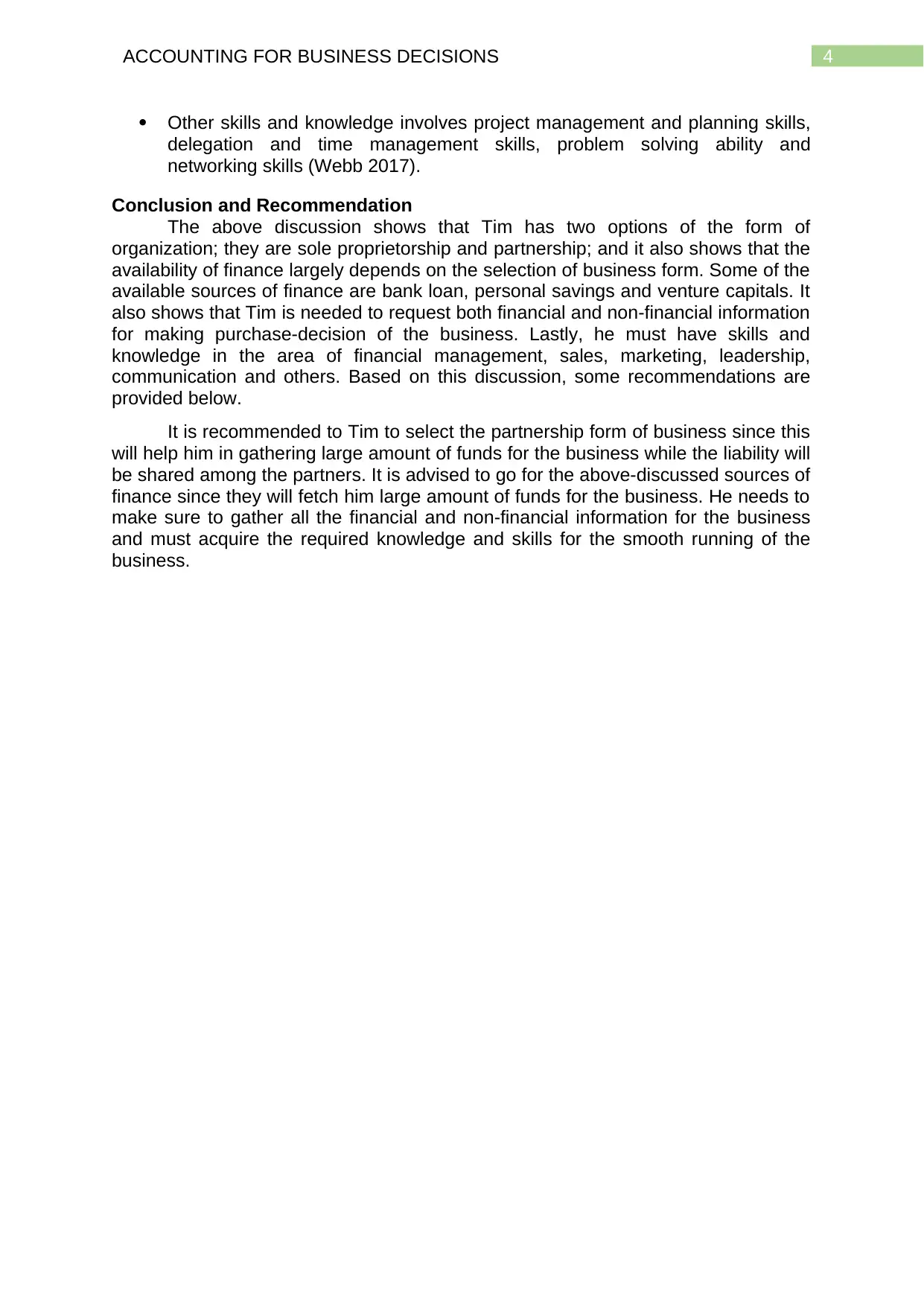
4ACCOUNTING FOR BUSINESS DECISIONS
Other skills and knowledge involves project management and planning skills,
delegation and time management skills, problem solving ability and
networking skills (Webb 2017).
Conclusion and Recommendation
The above discussion shows that Tim has two options of the form of
organization; they are sole proprietorship and partnership; and it also shows that the
availability of finance largely depends on the selection of business form. Some of the
available sources of finance are bank loan, personal savings and venture capitals. It
also shows that Tim is needed to request both financial and non-financial information
for making purchase-decision of the business. Lastly, he must have skills and
knowledge in the area of financial management, sales, marketing, leadership,
communication and others. Based on this discussion, some recommendations are
provided below.
It is recommended to Tim to select the partnership form of business since this
will help him in gathering large amount of funds for the business while the liability will
be shared among the partners. It is advised to go for the above-discussed sources of
finance since they will fetch him large amount of funds for the business. He needs to
make sure to gather all the financial and non-financial information for the business
and must acquire the required knowledge and skills for the smooth running of the
business.
Other skills and knowledge involves project management and planning skills,
delegation and time management skills, problem solving ability and
networking skills (Webb 2017).
Conclusion and Recommendation
The above discussion shows that Tim has two options of the form of
organization; they are sole proprietorship and partnership; and it also shows that the
availability of finance largely depends on the selection of business form. Some of the
available sources of finance are bank loan, personal savings and venture capitals. It
also shows that Tim is needed to request both financial and non-financial information
for making purchase-decision of the business. Lastly, he must have skills and
knowledge in the area of financial management, sales, marketing, leadership,
communication and others. Based on this discussion, some recommendations are
provided below.
It is recommended to Tim to select the partnership form of business since this
will help him in gathering large amount of funds for the business while the liability will
be shared among the partners. It is advised to go for the above-discussed sources of
finance since they will fetch him large amount of funds for the business. He needs to
make sure to gather all the financial and non-financial information for the business
and must acquire the required knowledge and skills for the smooth running of the
business.
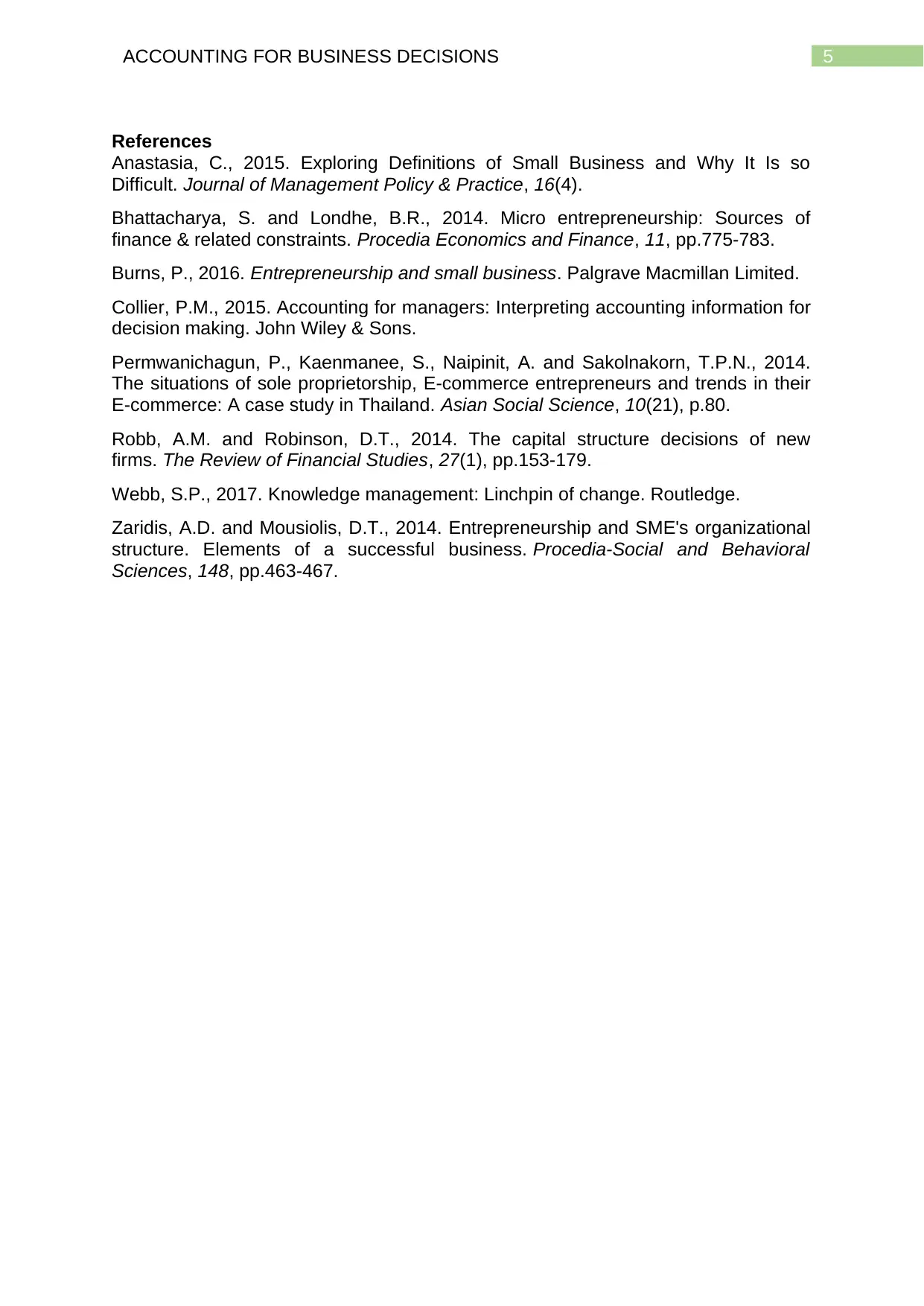
5ACCOUNTING FOR BUSINESS DECISIONS
References
Anastasia, C., 2015. Exploring Definitions of Small Business and Why It Is so
Difficult. Journal of Management Policy & Practice, 16(4).
Bhattacharya, S. and Londhe, B.R., 2014. Micro entrepreneurship: Sources of
finance & related constraints. Procedia Economics and Finance, 11, pp.775-783.
Burns, P., 2016. Entrepreneurship and small business. Palgrave Macmillan Limited.
Collier, P.M., 2015. Accounting for managers: Interpreting accounting information for
decision making. John Wiley & Sons.
Permwanichagun, P., Kaenmanee, S., Naipinit, A. and Sakolnakorn, T.P.N., 2014.
The situations of sole proprietorship, E-commerce entrepreneurs and trends in their
E-commerce: A case study in Thailand. Asian Social Science, 10(21), p.80.
Robb, A.M. and Robinson, D.T., 2014. The capital structure decisions of new
firms. The Review of Financial Studies, 27(1), pp.153-179.
Webb, S.P., 2017. Knowledge management: Linchpin of change. Routledge.
Zaridis, A.D. and Mousiolis, D.T., 2014. Entrepreneurship and SME's organizational
structure. Elements of a successful business. Procedia-Social and Behavioral
Sciences, 148, pp.463-467.
References
Anastasia, C., 2015. Exploring Definitions of Small Business and Why It Is so
Difficult. Journal of Management Policy & Practice, 16(4).
Bhattacharya, S. and Londhe, B.R., 2014. Micro entrepreneurship: Sources of
finance & related constraints. Procedia Economics and Finance, 11, pp.775-783.
Burns, P., 2016. Entrepreneurship and small business. Palgrave Macmillan Limited.
Collier, P.M., 2015. Accounting for managers: Interpreting accounting information for
decision making. John Wiley & Sons.
Permwanichagun, P., Kaenmanee, S., Naipinit, A. and Sakolnakorn, T.P.N., 2014.
The situations of sole proprietorship, E-commerce entrepreneurs and trends in their
E-commerce: A case study in Thailand. Asian Social Science, 10(21), p.80.
Robb, A.M. and Robinson, D.T., 2014. The capital structure decisions of new
firms. The Review of Financial Studies, 27(1), pp.153-179.
Webb, S.P., 2017. Knowledge management: Linchpin of change. Routledge.
Zaridis, A.D. and Mousiolis, D.T., 2014. Entrepreneurship and SME's organizational
structure. Elements of a successful business. Procedia-Social and Behavioral
Sciences, 148, pp.463-467.
⊘ This is a preview!⊘
Do you want full access?
Subscribe today to unlock all pages.

Trusted by 1+ million students worldwide
1 out of 6
Related Documents
Your All-in-One AI-Powered Toolkit for Academic Success.
+13062052269
info@desklib.com
Available 24*7 on WhatsApp / Email
![[object Object]](/_next/static/media/star-bottom.7253800d.svg)
Unlock your academic potential
Copyright © 2020–2025 A2Z Services. All Rights Reserved. Developed and managed by ZUCOL.



